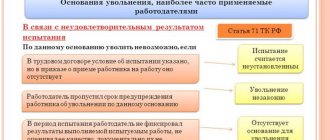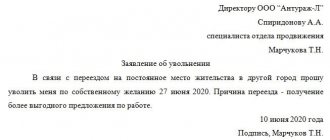Is it possible to fire retroactively?
If we turn to the labor code, it is not possible to dismiss an employee retroactively; such dismissal is a direct violation of the employee’s rights, and therefore he has every right to go to court. However, there are situations that are specified separately in legislative acts.
For example, an employee is absent from his work month for quite a long time, or rather 6 months. The employer makes a decision on dismissal. How to fire an employee in this case? There is no need to dismiss for absenteeism in such a situation, due to the fact that the reason why the employee is absent for so long may be valid. And if the real circumstances of the employee’s absence are clarified, it is possible that he will have to be dismissed under another article. What should the employer do in this case:
- The first step is to issue a reprimand to the employee for systematically violating the terms of the employment contract;
- After this, the employer has the right not to accrue wages to such an employee;
- During the employee’s absence, the employer has the right to hire another employee by concluding a fixed-term agreement with him;
- Then the employer must apply to the court to declare the employee missing;
- By a court decision, an employee can be dismissed (83 Labor Code of the Russian Federation);
- If the employee is wanted and the reason for his absence is not valid, he is fired for absenteeism. The employee is fired from the moment he is reprimanded.
Legislative nuances
According to the letter of the law, is it possible to dismiss an employee retroactively? Such dismissal on a legal basis is permitted in the following cases:
- death of a citizen;
- recognition as missing by court decision.
Difficulties in severing relations arise for an employer when collaborating with persistent violators of labor discipline. Even in the case of a long absence from the workplace, the administration, in order to obtain legal termination, is obliged to provide the right to an explanation to the “offending” employee or present an act of refusal to write an explanatory note drawn up by the commission. In the absence of documents, it is impossible to establish that the reason for absence from work is not valid.
Is it possible to fire someone for absenteeism retroactively when the circumstances are clarified? An erroneous understanding of the interpretation of Article 84.1 of the Labor Code of the Russian Federation, which considers the last day of cooperation to be the last working day, except in cases where the employee did not work with the right to retain his job, allows the employee to be dismissed on the date preceding the absence.
In fact, retroactive dismissal for absenteeism is impossible until the reasons are clarified. After all, on the date of absenteeism, the employee retained his job, and the employer did not take this fact into account when terminating the contract. Logically speaking, a citizen could have a valid reason for absence, about which the employer was in the dark. Then how can the unknown be classified as absenteeism?
- Dismissal for non-compliance with the position held according to the Labor Code of the Russian Federation
Another common misconception is the desire to fire an employee for inadequacy for the position held. Termination of labor relations under paragraph 3 of Article 81 implies the conclusion of an attestation issued by a special commission within a specifically established time frame. What it means to be unsuitable for a position is determined by experts, not by the administration. Will the qualification commission draw up a “verdict”, and also retroactively?
Although there is a Letter of the Federal Service for Labor and Employment No. 1074-6-1 dated June 11, 2006, which allows for retroactive dismissal for absenteeism on the day preceding the offense. However, the document has a private clarification nature, given to the organization in response to a specifically formulated request.
Employer's liability
If an employee is dismissed retroactively, the employer faces liability for (5.27 Code of Administrative Offenses of the Russian Federation). Responsibility is provided due to the fact that the employer violated the wording of the entry in the employee’s employment record. The fine will be as follows:
- 1000 – 5000 rubles for an official;
- 1000 – 5000 rubles for an entrepreneur, and the court may impose a ban on carrying out activities for up to 3 months;
- 30,000 – 50,000 rubles for a legal entity, as well as a ban on conducting activities for up to 3 months.
In case of repeated violation, the employer also faces a ban on employment for 1 to 3 years.
Consequences of illegal actions and punishment for them
For an employer, termination of a contract on a previous date threatens:
- inspections by authorized bodies;
- issuing warnings and orders;
- fines.
In this case, punishment threatens both legal entities and officials. The latter, for example, a director or a personnel officer, an accountant, may be deprived of the right to engage in certain activities due to violations, that is, disqualified.
Personnel employees and accounting departments should act only on the basis of an order from their superiors. In this case, responsibility rests with the management who ordered the dismissal on the previous date.
Employer's liability
For retroactive termination of a contract with a citizen, the employer faces administrative liability, according to Art. 5.27 Code of Administrative Offenses of the Russian Federation. Punishment involves significant penalties, as well as disqualification for a period specified by law. Withholding of funds is assigned by the labor inspectorate.
The restoration of a citizen to his position and payment of compensation to him is approved by a court decision. The bailiff is responsible for the execution of the decision.
If retroactive dismissal was used to conceal criminal acts (deliberate bankruptcy, illegal entrepreneurship, use of fraudulent schemes, etc.), the employer may be held criminally liable.
Possible fines
Administrative liability for retroactive dismissal involves the withholding of fines from the employer in the following amount:
- 1-5 thousand rubles. — from officials and individual entrepreneurs;
- 30-50 thousand rubles. - from organizations.
In case of repeated violation, the amount of sanctions increases:
- 10-20 thousand rubles. or suspension from work for up to 3 years - for officials;
- 10-20 thousand rubles. — for individual entrepreneurs;
- 50-70 thousand rubles. - for organizations.
Dismissal of an employee by a previous date always poses a danger to the employer. It is recommended to resort to retroactive termination of the contract only as a last resort and in the absence of other options.
The employee has the right to appeal such dismissal in court, seek reinstatement and recovery of compensation in his favor. The employer in such a situation faces administrative and even criminal liability.
What to do if you need to formalize your dismissal retroactively
Litigation for illegal dismissal lasts quite a long time and any company does not want to get involved in it. In this regard, employers try to issue it retroactively, but by agreement with the employee. Such dismissal has no actual justification from a legislative point of view, but companies often use it.
The disadvantage of such a dismissal is that the employer will always be found guilty of this dismissal. Of course, if the employee goes to court, but no one is immune from this. Therefore, it is worth finding the grounds that are provided for by law and terminating the contract with current dates, although this is a troublesome task. When going to court, the employer’s behavior may be considered as misleading a third party, since the actual date of dismissal is distorted.
Grounds for retroactive dismissal
- At the initiative of the employee. In this case, the employee writes a statement indicating the required date. The dismissal documents date from the same date;
- Agreement between employee and employer. In this case, not only the desired date of dismissal is indicated, but also the actual date of termination of work;
- Employer initiative. You can also fire an employee for absenteeism. To do this, it is necessary to record all absenteeism. It should be remembered that absenteeism is a gross violation of labor discipline, which leads to unilateral dismissal. The contract is terminated by the date on which the employee last visited his workplace. The corresponding wording should also be included in the labor contract. If the employer simply notifies the employee of the dismissal retroactively, then this is an offense that is grounds for going to court;
- Death of an employee. When the fact of death is established, the termination of the contract with the employee is formalized by an order indicating the actual date. In the employment record, the date of dismissal is indicated according to the actual date of death. The death certificate is indicated as the basis for termination of the contract.
Is there a legal way
It is worth emphasizing once again that the law does not provide for the possibility of retroactive dismissal. But if the employer is confident in his employee and does not think that the inspectorate is checking him in a certain way, then he can, by agreement with the employee, terminate the contract by putting an earlier date in the dismissal order.
Such a procedure is possible within the framework of Art. 80 of the Labor Code of the Russian Federation, i.e. upon dismissal of one's own free will.
In this case, the employee draws up a standard application, only putting the past date on it. All documents for dismissal are also formalized further in a different number (dismissal order, entry in the work book, etc.). This method has another unpleasant nuance. It consists of completed accounting, tax and financial statements. Those. It turns out that the employee is supposedly no longer at the company, but the organization transfers money for him. By the way, such an incident can be regarded as one of the evidence of an offense.
In any case, upon dismissal, no matter how it is formalized, the standard procedure is followed:
- The employee either submits an application with a request to dismiss and make a settlement in the name of the employer, or signs an agreement with the latter;
- The employer draws up a dismissal order, which the employee must read and sign;
- A corresponding entry is made in the work book and personal card;
- The accounting department makes the final settlement with the employee, the work book is returned to him and he is given copies of 2-NDFL certificates.
It should be borne in mind that if the dismissal is formalized retroactively, then the monetary settlement will be based on the date of official termination of the employment contract, i.e. An employee will not receive money if he actually worked for a longer period.
What date to retroactively dismiss?
Depending on the basis for the dismissal of the employee, the corresponding date is set retroactively:
- The employee’s desire is to put the same date on the work record as in the order;
- Agreement of the parties - the date agreed upon by the employee and the employer;
- Absenteeism – the date on which the employee worked for the last day is indicated, and it is necessary to refer to a gross violation of labor regulations;
- Death - the work record indicates the date when the employee died, with a death certificate indicated as the basis.
Backdated wrongful termination
If an employee was fired retroactively without legal grounds, then he has the right not to submit an application for dismissal and not to sign the corresponding order. First, you should contact the company’s trade union or labor dispute commission. If the employer does not want to comply with the instructions of these authorities, it is necessary to apply to the court. According to the court decision, the employee must be reinstated in his position, as well as paid the average salary for the entire period before the day of reinstatement. In addition, the court may order the employee to pay moral damages.
Important! You can challenge illegal dismissal only within one month. If the employee does not apply within the specified period, the court will refuse to consider the application.
As a rule, the courts side with the employee, since the very fact of retroactive dismissal is already a direct violation. Therefore, before deciding on this option of dismissal, the employer should assess all possible risks.
What to do in case of illegal dismissal
Read: Illegal dismissal of an employee: reasons, sample application, consequences
If an employee’s employment contract was terminated retroactively, and he does not agree, then you should not despair. It is clear that it is unpleasant to continue working in an organization where they do not want to see you, but this is not necessary. It will be enough to restore justice, receive the compensation due, and then resign according to all the rules.
First, you need to submit an application to the labor inspectorate at the location of the enterprise. A response to a complaint must be received within 30 days. In addition, you can submit an application to the Prosecutor's Office.
If both authorities give an unpromising answer, then there is only one way out - to file a claim in court. If the plaintiff wins the case, the employer will be obliged to:
- Reinstate the injured person in his position;
- Make a cash payment for all days that were missed due to the fault of the employer;
- Pay compensation for moral damage;
- Pay all legal costs. Including the services of a lawyer who defended the interests of the injured party;
- Pay an administrative fine.
By the way, I can advise anyone who doubts – don’t be afraid. As judicial practice shows, a lot of positive decisions are made in favor of the plaintiff in such cases.









